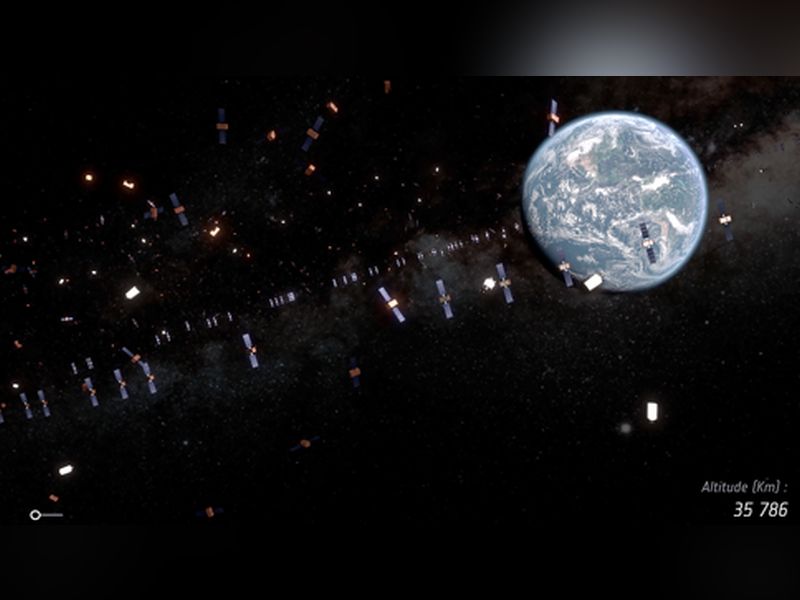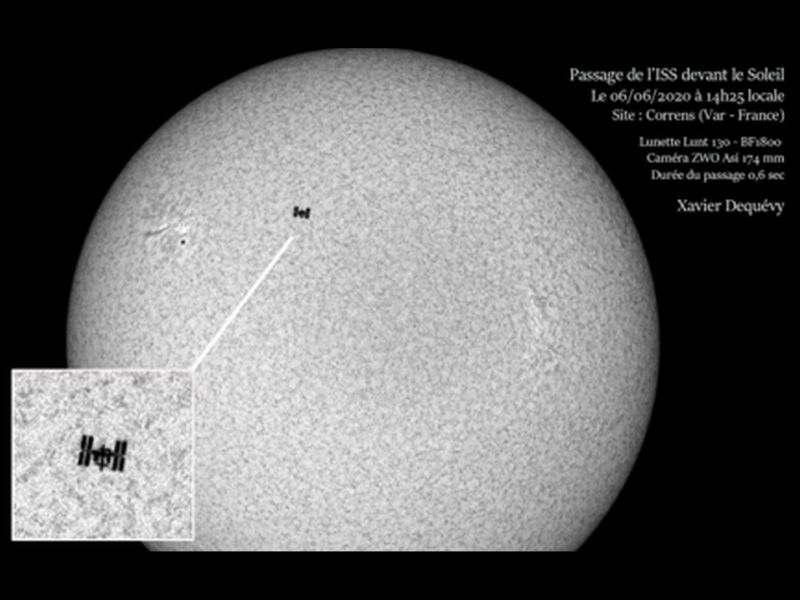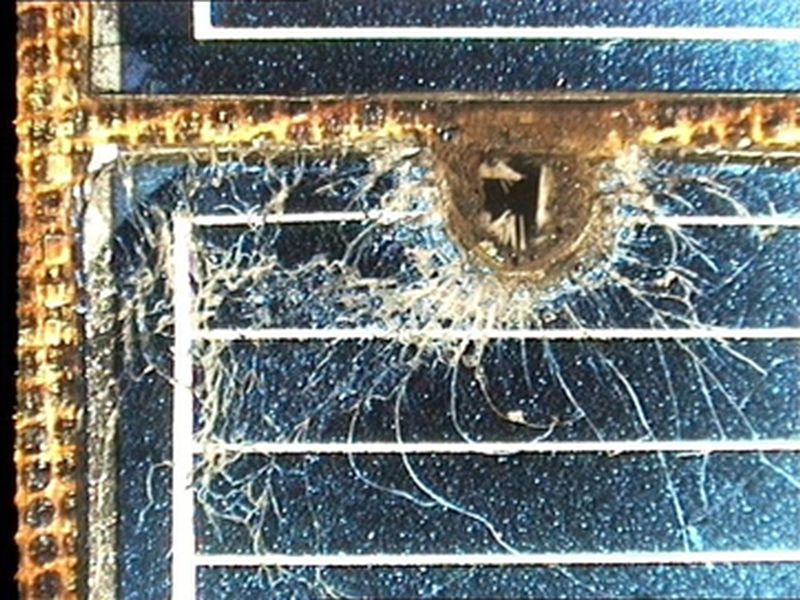In Space
We depend daily on satellites: this increases the exposure of the society to Space Weather hazards. Sending an email can go through one or more of them. We guide ourselves by GPS, decide what to wear based on the weather, watch television from any country from our couch, we phone, we text, we chat we post on social media, we browse the web, we listen to the radio. But also monitor the rise of ocean waters , prediction of global warming, for which we try to disentangle the natural space climate causes from those of anthropogenic origin, military troop movements, atomic or volcanic explosions, giving alerts: all these applications require communications between the ground and space, sometimes between the satellites themselves. However, many hazards related to space weather can affect them. What are they?
Electrical discharges on geostationary satellites

Satellite orbits are classified into several types. Geostationary satellites fly at an altitude of just under 36 000 km. There, the centrifugal force that tends to expel them from the Earth compensates for the gravity that brings them back. The geostationary orbit has limited applications, because it is constrained to the plane of the equator, but it is extremely popular because the satellites stay over the same point on the Earth. Therefore, they are permanent relays for all our communications, our television broadcasts, for classical meteorology and many other applications. When the Sun is quiet, the magnetopause - the boundary between the zone where we are under the influence of the Earth's magnetic field and the zone where we are exposed to the solar wind - is located, in the direction of the Sun, at about 10 Earth radii (60,000 kilometres) from the Earth surface. The geostationary orbit nominally entirely lies within the magnetosphere, above the Van Allen belts. The satellites are sheltered from the solar wind, and this is one of the reasons why the idea that the magnetosphere "protects" us is often found. But if the solar activity becomes strong, the magnetopause, on the dayside, is pushed by the solar wind towards the Earth, and drops down several thousand kilometres. The geostationary satellites are then in the magnetosheath where electrical charges accumulate or get even directly exposed to solar wind particles precisely when those are most aggressive. The effects can be significant: radiation degradation of electronics or parasitic electric currents that disturb or permanently damage it.
Satellite Friction

The zoo of orbits is very populated and meets specific needs: do we want to fly over the same geographical area several times a day, do we want to see the geographic poles, do we want to have a global or local view of the Earth? Often, commercial reasons come into play. Thus, meteorology, communications, positioning: each application has its own orbit. The lower the satellite flies, the denser the surrounding atmosphere is - even if it remains at the level of already advanced vacuum not so easy to reach by instruments on ground - and the greater the friction it exerts. If a solar flare occurs, the ultraviolet radiation increases, creating a strong excitation of the upper atmosphere on the Earth's dayside. Consequently, the air heats up and expands upwards The satellites in low Earth orbit (LEO, below 2,000 km altitude) experience the friction increase. They are slowed down and dive. And as they dive, they accelerate under the effect of the Earth's gravity. To get them back to their flight altitude, they must perform manoeuvres that consume fuel and shorten their life. Imagine what this can cost on a fleet of satellites. Obviously, the loss of communications is immediate. A notable, recent event occurred on Starlink satellites. On February 3, Falcon 9 launched 49 Starlink satellites to low Earth orbit. The satellites were significantly impacted by a geomagnetic storm which caused atmospheric drag to increase up to 50 percent higher than during previous launches. Forty satellites were forced to reenter the Earth’s atmosphere. But the atmospheric drag influence by this event was negligible to big events documented by space climate studies – such upheaval would mean partial orbital degradation or loss of most of LEO satellites – at once!
Single Events Upsets

The fastest solar wind particles – by colliding with the satellite's hull create particle cascade that spreads through the satellite. If respective parasitic current reaches the onboard computer, it can completely disable the entire satellite. Most of the time, a reset is enough, like on a personal computer. But sometimes, the satellite's attitude control is affected: nothing indicates anymore where the Earth is and the spacecraft starts spinning itself, unable to position itself. A satellite worth several million euros lost from the hit of an energetic particle…
Solar Panels

Other damage, perhaps less drastic, can occur. Solar panels, obviously directed towards our star, are the first affected by increases in extreme ultraviolet radiation. The characteristic of this radiation is being so energetic that it can tear electrons from any atom or molecule, which irreversibly degrades. Whether we use metals, plastics, or glasses, such a deterioration is inexorable. The situation is even worse for space-based telescopes observing the Sun. Imaging instruments can see the quality of its observations degraded by a factor of two in fifty days, and by a factor of up to 800 in six months.
Ageing of Satellites

Solar wind and radiation conspire to degrade the electronics of satellites. For those flying below about a thousand kilometres, there is the added effect of atomic oxygen in the Earth's atmosphere. Here again, solar activity has an influence. The more there is, the more this oxygen is ionized. Once ionized, it travels faster carried by the magnetic and electric fields, and its chemical properties become more effective in corroding the metallic parts.
Collision of Satellites

Satellite orbits can decay, and the closer they are to the Earth, the more the friction against the atmosphere, which depends on the solar activity, accelerates their descent. What happens to them at the end of their life? At geostationary orbit, they are navigated outwards to be expelled into a garage area – graveyard orbit, only a couple of hundred kilometres above the geostationary. This is only a temporary solution: sooner or later they will have to be forced another 600 km above the geostationary orbit, so that they can drift slowly before disappearing - in the very long term - into deep space. Satellites in low orbit plunge into the atmosphere where they burn up. The size of a satellite can be about the same as a car. The pollution generated by a single satellite is therefore not considerable. However, between 1957 - the launch of Sputnik - and February 2020, about 9,600 satellites were launched. More than one percent is still active - about 2600 in February 2020... Of the total number of active satellites, the vast majority fly in low orbit (2070 satellites), the rest are in geostationary orbit. So more than seven thousand satellites have decayed in atmosphere or are still in space, out of order. To evaluate the number of satellites that have been affected by a space weather and space climate related failure is quite a feat. A few years ago, a study was conducted for the European Space Agency. During the investigation, none of the space safety managers of the space operators ever admitted a failure. However, in 2008, Mak Tafazoli, from the Canadian Space Agency, tried his own evaluation. According to him, there were 156 failures between 1980 and 2005 on both civilian and military satellites, 25 of which were related to space weather and space climate. The case will soon become a major issue with the launch of hundreds, or even thousands of small communication spacecrafts by companies such as SpaceX or Amazon. These will soon transform the Earth space environment in an uncontrollable and dangerous trashcan.
